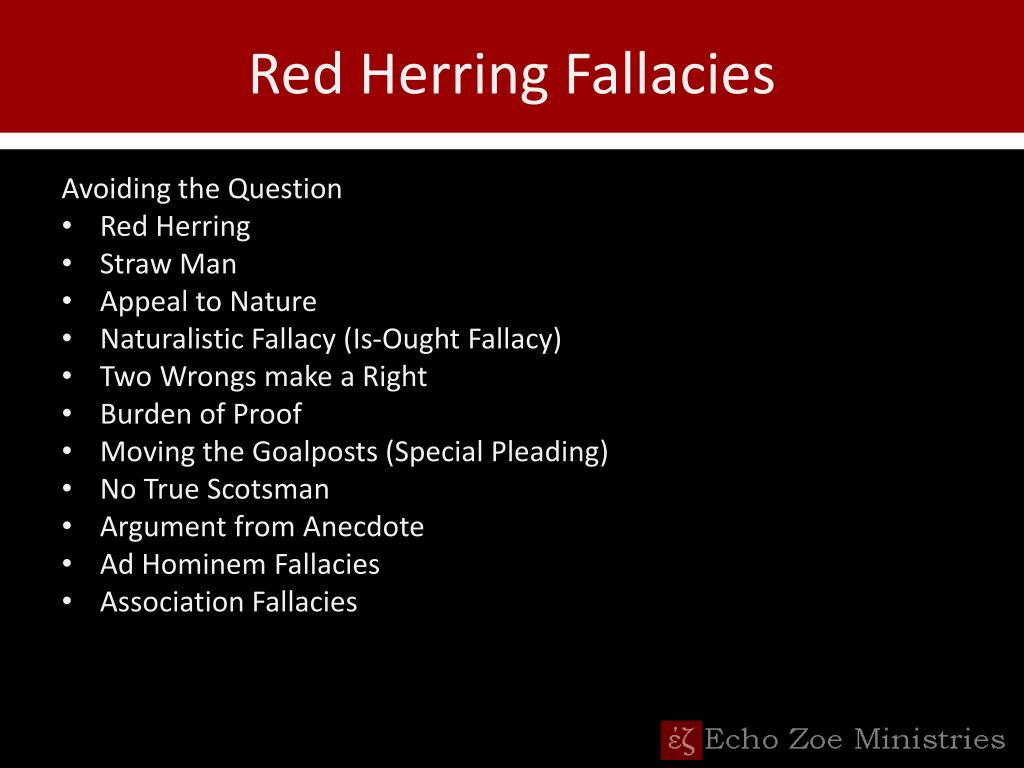

Note how there’s superficial similarity between the red herring and the original topic, since they both relate to education this is done to hide the use of the red herring, and make it appear as if it’s a relevant part of the original discussion.įurthermore, the following is an example of a red herring in an advertisement: Here, the fallacious red herring is used to distract viewers from the original topic. But what about recent the recent controversy with the school board’s election procedure? Reporter: Students are organizing a march because they want their opinions about the environment to be heard. Similarly, the following is an example of a red herring in the media: As in the case of the previous example, this is also an example of the red herring fallacy, since it involves the use of a red herring with the intention of distracting the audience in a misleading manner.

Here, the interviewer asks a valid question, and the politician responds with a red herring, in the form of a vague and seemingly related statement, which is meant to distract listeners and mislead them into believing that the politician directly answered the question.

Politician: I have been working hard ever since I came into office, and I’m happy to say that I met with many business leaders throughout the country, who all say that they’re glad to see that our hard work is paying off. Interviewer: It’s been two years since your policies were implemented, and so far they have failed to reduce unemployment rates. In addition, the following is an example of a red herring in a political discussion: This is therefore also an example of the red herring fallacy, since the red herring in this case is used with the intent of distracting the other person and changing the topic. Here, Alex raises a valid concern, which Bob avoids addressing by using a red herring in order to change the subject. Actually, I’m working on a really cool project now, want to see some screenshots? For instance, the following is an example of the use of a red herring in a simple workplace conversation:Īlex: You promised me yesterday that you were going to take care of this task.īob: Oh yeah, that. Other examples of red herrings appear in various contexts, and we encounter them often in our everyday life. This is an example of a red herring in general and of the red herring fallacy in particular, since the executive responds to the question using irrelevant information, in an attempt to evade it and distract listeners. Origin and history of the term ‘red herring’Ī simple example of a red herring is a corporate executive who’s asked “what do you think about your company’s new environmental policy?”, and responds by saying “the company is making great progress in product development that we hope will help our customers”.Related fallacies and rhetorical techniques.As such, in the following article you will see examples of red herrings, learn more about red herrings and about the red herring fallacy, and understand how you can properly respond to people who use red herrings in a fallacious manner. For example, if a politician is asked how they feel about a certain policy, they might use the red herring fallacy by discussing how they feel about a related topic instead, to distract people from their failure to answer the original question.īecause red herrings are frequently used in a variety of contexts, it’s important to understand this concept. The red herring fallacy is a logical fallacy where someone presents irrelevant information in an attempt to distract others from a topic that’s being discussed, often to avoid a question or shift the discussion in a new direction.

When it comes to rhetoric, the use of red herrings is often referred to as the ‘red herring fallacy’. Red herrings are usually used either as a literary device, such as when an author uses a side character to divert attention from another character, or as a rhetoric technique, such as when someone responds to a question with unrelated information in order to hide their refusal to answer the original question. A red herring is a piece of information that’s meant to distract people from something important in a misleading manner.


 0 kommentar(er)
0 kommentar(er)
